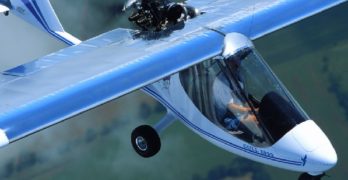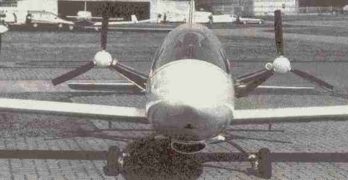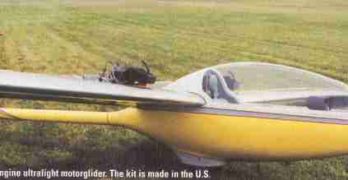A dashing hybrid from the European microlight scene European microlight designers are blazing new runways to the sky.
Two decades after the first powered hang gliders were turned into powered ultralights, companies now offer two styles of aircraft. As one would expect, many ultralight designers have evolved their airplanes in new ways.
These producers now offer flying machines that employ the best ideas of familiar old designs (such as sewn Dacron wings and aluminum-tubing main structures), but they combine these tried and true components with composite fuselages and welded steel parts. Many variations on this theme keeps a wide range of aircraft in the pipeline.
Taking a different approach are those designers who are emerging from the world of kit-built designs. Some developers have conventional general aviation or airline design backgrounds. Whatever their experience, these engineers create clean-sheet designs that have evolved since the early days of aviation design.
As each tries to create a new microlight, they are not bound by any traditions, other than the laws of aerodynamics.
Search Results for : flight design ct
Not finding exactly what you expected? Try our advanced search option.
Select a manufacturer to go straight to all our content about that manufacturer.
Select an aircraft model to go straight to all our content about that model.
Built for two
After ten years of producing exclusively single seaters, Tennessee-based TEAM Aircraft broke with tradition and rolled out their very first two seater, the Tandem Air-Bike, at Sun ‘n Fun ’96, following the company’s successful Air-Bike design debuted two years earlier.
Wayne Ison’s TEAM got a lot of attention from the Air-Bike – it being regarded as an aircraft you get on, not in. That same sporty, fun-to-fly concept has now stretched into a two-seat model.
Some buyers will use the Airbike Tandem for instruction under the training exemption to Part 103. Others will N-number the machine and use it for the occasional joy ride with a passenger. It should work well either way. In fact, the close-quarters tandem seating means that when the aircraft is flown solo, it should perform well and yet feel more like the agile single seater than some other designs. This theory has worked well for Kolb and their Firefly II, for example.
Facing the buying decision
What Kind of Pilot Are You?
Let’s just say you actually know yourself. While this sounds like a comment that deserves a “duh!” response, don’t be too quick to judge. If every pilot or buyer of an aircraft knew what he/she needed or wanted, my job would be easier. But it isn’t so. Most pilots know something about what they want, but many don’t have enough information to make the best decision.
Some readers are “experts.” A good many ultralight or light plane enthusiasts have been around long enough and owned enough of a variety of ultralights to know what they like. These veteran sport aviators represent a lot of combined experience. If you’re new to ultralight flying, I strongly encourage you to seek out local experts. They can be your very best source of information because they know you. (However, as I reminded you last time, remember that anybody selling any aircraft – whether their own or one they represent – has a bias that you must not overlook.
Dakota Hawk
Vintage looks. A few companies in aviation specialize in the look and feel of aircraft from yesteryear. These manufacturers offer aircraft that are reminiscent of days gone by in aviation. Visually and even in the way they fly, these machines can transport enthusiasts back to the so-called Golden Era when the nascent aviation industry offered simple, easy to fly aircraft like the Piper Cub and others. Today, most of these specialty aircraft are kit-built airplanes because the freedom of the Experimental 51% rule permits exploration that cannot be justified when making a fully FAA certified model. Some of these kit manufacturers hail from the ultralight community. Fisher Flying Products is one such company.
Second-Generation Fisher
In two ways, North Dakota-based Fisher Flying Products is a second generation company. First, the company now owned by Darlene Jackson and husband Gene Hanson was purchased from Mike Fisher, who subsequently started another business using his name.
Gull flying in a new millenium
It is Mark’s design philosophy to make the most efficient aircraft he can, one that will use the least fuel. He defines himself as “a minimalist,” and this sentiment is carried throughout this beautifully optimized aircraft.
To me, Mark appears to have grown increasingly comfortable in his role within ultralight aviation. Relaxed and confident, he knows he has created a superior flying machine.
He also smiles a lot more these days in my opinion, thanks to a wonderful woman named Leslie who accompanied him to AirVenture 2000 in Oshkosh, Wisconsin. Married a year and a half ago, the two complement each other and make a good team.
No more tight squeezes
Perhaps it was this new personal relationship that motivated Mark to pay more attention to creature comforts. Notably, the Gull 2000 is wider than the previous single-seat or tandem two-seat Thunder Gull aircraft. Considering Mark is a lean and healthy vegetarian, his concern for broader pilots is no doubt appreciated.
Polaris Slip
Here’s Polar Star’s entry in the minitrike sweepstakes.
You probably know Polaris even if you aren’t aware of the company name. Odds are good you’ve seen a picture of the Polaris inflatable flying boat. This is a trike with a small boat built around a steel trike frame. It looks unusual and remains unique.
Polaris claims to have shipped over 600 of these flying inflatable boats, once known as the Air Dinghy. The company reports these are flying around the world, owned by tourist resorts, Navy and police departments, Greenpeace ships, yacht owners, research marine institutions, and private pilots.
The company originated in Italy but opened an American office after founder, Doi Malingri, retired in Florida. Along with several Americans including Dave Melillo and Vince Kaufman, Malingri has established a U.S distribution center called Polar Star Group, a division of Polaris Motor.
Established in 1982, Polaris is experienced in aircraft manufacturing.
Dockweiler Reunion
Dockweiler Beach renews hang gliding memories.
Most KITPLANES readers probably don’t think of hang glider pilots as old folks. Indeed, it remains a younger man’s flying sport due to the athletic nature of the launch and landing. (At least that’s true if you don’t count the 30-40% of all launches that are done via aerotowing behind a specially built ultralight.)
Nonetheless, this event at a famed California beach site was dubbed the Geezer Fly-In by many who celebrated in good humor at the landmark where so many first got their feet off the ground under a hang glider. Many of those present qualify as fifty somethings.
“Nearly 400 pilots attended,” says Michael Riggs, himself a figurehead in the early days of hang gliding. Riggs started Seagull Aircraft, which became highly successful selling thousands of his distinctive hang gliders with the smoothly curved leading edges.
He also described the event this way: “There wasn’t a dry eye all day.” Of the hundreds who gathered, many had not seen each another in the last 20 years.
Hang Gliding Records
What’s in a name? A Texas-based event, last summer’s World Record Encampment, predicted accurately its own success; two top hang glider pilots set world records for distance flying and broke another record that stood for nearly a decade.
On July 19, Dave Sharp flew his A.I.R. ATOS rigid wing hang glider for an astounding 311 miles (501 kilometers), narrowly beating the long-held record of 308 miles set by another leading competitor, Larry Tudor.
Tudor first broke the magical 300-mile barrier by flying 303 miles in July, 1990. He repeated this achievement, flying 308 miles several years later, but nearly a decade passed with no other pilots exceeding 300 miles. That unique status was shattered thanks to participants at the World Record Encampment 2000.
Sharp flew more than 9 hours to earn his world record. The one that people will remember is the 311-mile flight of straight distance, but along the way he also set a record for a flight to a declared goal of 203 miles.
FK-11
Let’s check out the FK-11 ultralight.
How would you like to own a Mercedes-brand ultralight? Today you can’t, and maybe you will never be able to, but you may be able to purchase a slick little ultralight called the FK-11 that is well known to Mercedes. And if you want a Mercedes-powered ultralight today, one is being sold.
This month’s “Light Stuff” again ventures across the Atlantic to look at another fascinating aircraft coming from the European sport aircraft community. The pictures accompanying this column feature the FK-11, a prototype design from Otto Funk, lead designer for the German ultralight manufacturer, B&F Technik Vertriebs.
B&F is what Americans might call a family operation. Son Peter Funk runs the business. Otto is his father, who owns an engineering firm and works with Peter as B&F’s design team. Before starting his own enterprise, Otto was an engineer working for Airbus.
Twin-Prop FK-11
The FK-11 is a single-engine ultralight using two aft-mounted props that extend from the fuselage midsection on upward-angled supports.
Esprit
Meet the Esprit – a twin-engine ultralight motorglider.
Soaring enthusiasts who want to self-launch their aircraft are limited to simple hang gliders on one end and expensive motorgliders on the other. Performance for these machines ranges 15:1 to 50:1. To get one you’ll spend $5000 or $200,000. What you could not do is spend $20,000 to get medium performance*… until now.
Debuting his machine at AirVenture 2000 airshow, Dobro Hajek brings a modern soaring aircraft to the ultralight community. I believe he will also find significant interest from two other groups: sailplane and hang glider pilots. Each loves dedicated machines without engines but many will also prefer an aircraft that can launch itself.
Welcome, Esprit
With its distinctive compound-tapered wings and winglets and its dual engines with folding props, the sleek Esprit goes a long way past the Aero Dovron that Hajek (pronounced HAY-yek) once imported. The Straton D-8 was an interesting little motorglider with a high wing and struts but at 17:1, this inexpensive machine didn’t have the go power it needed to attract a solid market in the United States.






